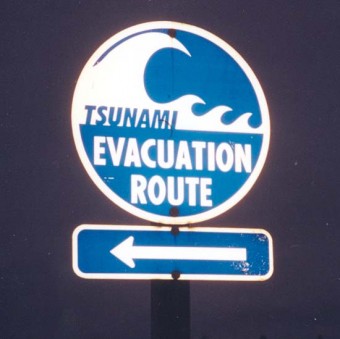Tsunamis Are Not The Same As Tidal Waves
 Myth: Any big surge of water from the oceans is called a tidal wave; the terms “Tsunami” and “Tidal Waves” mean the same and are interchangeable.
Myth: Any big surge of water from the oceans is called a tidal wave; the terms “Tsunami” and “Tidal Waves” mean the same and are interchangeable.
Tsunamis are mistakenly called tidal waves because, when approaching land, they look as a tide which suddenly rushes away and crashes back in a form of a huge wave. It is true that both of these types of waves may be very destructive. However, there is a significant difference between tsunamis and tidal waves based on their origins and characteristics.
A tidal wave is quite a predictable event impacted by the atmosphere. It is a result of the daily tides caused by the imbalanced, gravitational influences of the Moon, Sun, and planets (hence the name). Tidal waves are most pronounced in narrow bays or in rivers along the coast. Due to this fact, water levels may raise by several feet in a matter of hours. It is also possible that a tidal wave will burn out before it reaches the coast. As a rule, tidal waves follow the currents and are unlikely to cause a landfall in areas of temperate climates or northern countries.
A tsunami, on the other hand, is an extraordinary event. It is a series of waves caused by a rapid, massive displacement of the seafloor or disruption of standing water. The ocean floor may be displaced by an earthquake; landslides moving into oceans, bays, or lakes; volcanic eruptions; a crashing asteroid; or underwater explosions, so the water column is uplifted. The most common reason for a tsunami is an undersea earthquake. The water above such an event is disturbed in such a way that it creates a surface wave with a speed of hundreds of miles per hour (typically around 500 mph on average). Because of the diverse causes, a tsunami has the potential to develop anywhere, unlike a tidal wave.
There is also difference in wavelengths between a tsunami and a tidal wave. While a tsunami differs from 5 minutes to an hour, the wavelengths of a tidal wave differ from 12 to 24 hours.
So, as tsunamis are not related to tides, it is incorrect to consider them a type of tidal waves. Although, the impact of a tsunami could be influenced by the tidal level at the time it strikes.
Bonus Facts:
- The highest tidal waves are found in the Bay of Fundy, in the Canadian province of New Brunswick, where the water level can rise with the tide by 50 feet.
- The word ‘tsunami’ comes from Japanese, meaning “harbor wave”; the origin of the word refers to fishermen who usually didn’t notice tsunami waves in the open sea and only saw the damage on the coast. In German, ‘tsunami’ is ‘Flutwelle’ which means ‘flood wave’ and seems to be more relevant to what it actually is. In scientific community, tsunamis are often referred to as “seismic sea waves”, even though not all tsunamis are caused by seismic activity.
- A tsunami wave isn’t too much different in height compare to other waves in the ocean (about one meter only out from the shore). But it is quite long so it piles up when approaches land. That is why a tsunami is generally goes unnoticed in the open ocean. In addition, tsunamis move the depth of the ocean and not just its surface. That is why tsunamis contain such powerful energy and move at great speed for unbelievable distances, still remaining powerful enough to cause a devastating damage along coastlines. Tsunamis can also travel up rivers and streams that lead to the ocean.
- The Indian Ocean Earthquake on December 26, 2004 had a magnitude of 9.15 and triggered a series of tsunamis that killed approximately 230,000 people across a several countries. It was the deadliest tsunami in recorded history.
- There is a natural tsunami warning: approaching tsunamis are usually heralded by noticeable rise or fall of coastal waters.
Expand for References:
| Share the Knowledge! |
|





Both these terms are the same. It is not incorrect to refer to a large ocean wave as a Tidal Wave because that is its name. It is the word we use for the phenomenon, not a definition of it. In both origins people saw a large wave and named it Tidal Wave in North America and Tsunami in Japanese speaking areas. By your above definitions both are equally wrong. It is In Vogue now to be cool and use the Japanese term over the original North American one. While we may be forgiven for ditching a word because it is incorrect, what is the point of getting rid of one wrong term to adopt another equally wrong term? To me a large wave will always be called a Tidal Wave; I don’t speak Japanese.
I realize this is an old thread, but I wanted to applaud your comment. The word tsunami is literally translated “harbor wave” and it is no more correct than the term tidal wave which we have been using to describe this phenomenon for decades. If we were going to borrow from another language there are other languages that have terms that would probably be more accurate. Or…. just call a wave generated by seismic activity a seismic wave.
seems to me these large waves you are talking about are both different kinds of waves. I am sure the Japaneese have a different name for a tidle wave and it is not tsunami.
When people say tsunami we all know how devastating any tsunami will be and tidel wave doesnt come near a tsunami in death tolls
i want to now the answer for this question,what is the one in which tusnamis are diffrent than other ways?